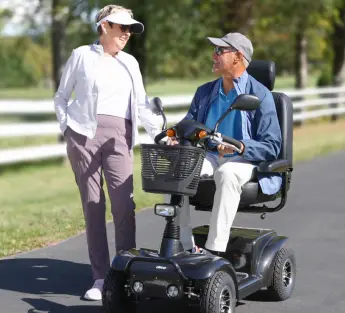Inside Lift Compatibility with Your Scooter or Power Wheelchair
Inside Lift Compatibility
Inside Lift Compatibility with Your Scooter or Power Wheelchair
There are four critical dimensions in assessing the compatibility of a power wheelchair or scooter with a particular lift and vehicle: Length, width, height, and weight.
To measure length and width:
-
Measure the scooter or power wheelchair from front to rear, at its longest point (including with rear casters trailing, if applicable), as well as side-to-side at its widest point. The reason why these dimensions are so important because they dictate whether the mobility product’s measurements fall with the platform lift’s dimensions, ideally with room to spare.
To measure height:
-
Measure the scooter or power wheelchair from the ground to the tallest point, with backrest folded if applicable. This helps to determine if it will fit through the vehicle’s rear hatch or side door opening, and into the vehicle’s interior.
Note: While vehicle manufacturers state the dimensions of hatch and door openings, they’re often measured at the tallest and widest points of the opening, which may not be entirely accurate. Openings are rarely perfect rectangles, where the height and width changes with the vehicle’s contours. For this reason, it’s important to measure the opening at multiple points to determine both the tallest and widest points, as well as the lowest and narrowest points to determine if the mobility product will fit within the vehicle.
Weight capacity is another critical aspect in selecting a lift for a particular mobility product, because the power wheelchair or scooter’s weight cannot exceed the lift’s weight capacity. It’s difficult to weigh a large mobility product like a power wheelchair or scooter; however, most manufacturers of mobility products publish the overall weight of the scooter or power wheelchair in the owner’s manual or on the manufacturer’s website. The mobility product’s overall weight must then be matched within the weight capacity of a lift. For example, if a scooter weighed 150 lbs., the appropriate lift’s weight capacity would be models with weight capacities of 150 lbs. or higher. A rule to remember is that the lift’s weight capacity should be equal to, or greater than, the mobility product’s overall weight.
If you remain concerned about your power wheelchair or scooter’s compatibility with a particular lift and vehicle, please inquire with one of our expert Product Specialists.
By Mark E. Smith
Inside Lift Compatibility
Inside Lift Compatibility with Your Scooter or Power Wheelchair
There are four critical dimensions in assessing the compatibility of a power wheelchair or scooter with a particular lift and vehicle: Length, width, height, and weight.





 Contact Us
Contact Us
 M-F 9am - 6pm ET
M-F 9am - 6pm ET
 Request parts
Request parts Request Service
Request Service
